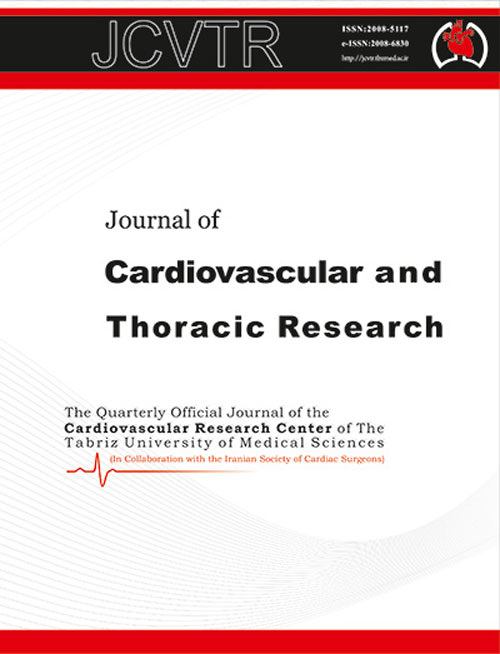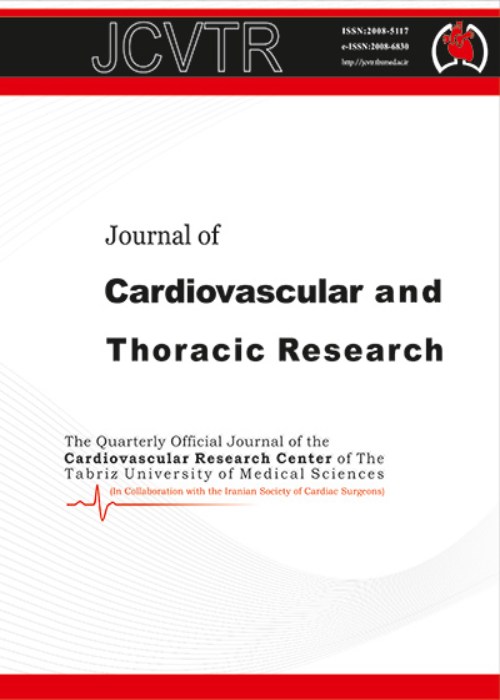فهرست مطالب

Journal of Cardiovascular and Thoracic Research
Volume:9 Issue: 4, Dec 2017
- تاریخ انتشار: 1396/11/09
- تعداد عناوین: 9
-
-
Pages 183-190IntroductionInflammation has a crucial role in the progression of cardiovascular disease in diabetes. Tumour necrosis factor-α (TNF-α) as an inflammatory marker induces angiotensin II (Ang II) related hypertension pathway in diabetic patients. Gut modulation via prebiotics may ameliorate hypertension caused by inflammation. The aim of this study was to investigate the role of sodium butyrate (NaBut) and inulin supplements on inflammatory and oxidative stress parameters in type 2 diabetic patients.MethodsIn this clinical trial, 60 overweight and obese diabetic patients were recruited and randomly allocated into four groups. The groups received, respectively, 600 mg/d NaBut (group A), 10 g/d inulin powder (group B), both inulin and NaBut (group C), or placebo (group D) for 45 consecutive days. Blood and stool samples were collected at baseline and after intervention. Quantitative real-time PCR analysis targeting the 16S rRNA gene of Akkermansia muciniphila was done. We assessed the TNF-α mRNA expression and the serum levels of the high sensitive C-reactive protein (hs-CRP) and malondialdehyde (MDA).ResultsThere was a significant increase in A. muciniphila percent change in inulin and butyrate supplemented groups (PConclusionIntervention had significant effects on inflammatory and oxidative stress parameters and led to improvement of hypertension. However, further investigations are needed to make concise conclusions.Keywords: Inulin, Sodium Butyrate, TNF, ?, Akkermansia muciniphila, Diabetes, Angiotensin Signaling Pathway
-
Pages 191-195IntroductionClopidogrel is a potent platelet activation and aggregation inhibitor that prevents thrombosis in coronary artery diseases (CADs). In comparison to locally produced generic one (Osvix®), original brand of clopidogrel (Plavix®) is expensive. This study was designed to evaluate the effectiveness and uniformity of Osvix® versus Plavix® in patients with percutaneous coronary intervention (PCI) by means of platelet aggregation indexes.MethodsThis randomized, double blind clinical study was conducted at Shahid Madani heart hospital, Tabriz, Iran, and 129 patients with previous PCI were enrolled in two independent treatment groups. All patients participated in this study were on dual antiplatelet therapy at least for 30 days. ASA 80 mg/d and clopidogrel 75 mg/d and a stat dose of 300 mg of clopidogrel before PCI were administered for all patients. To evaluate the anti-platelet activity, blood samples were taken from the patients and platelet aggregation test was performed.ResultsThe total study population represents a group of 129 patients (99 men and 30 women) with mean age of 57.7 ± 9.7 years with stable angina pectoris. The baseline characteristics and laboratory findings of two groups (except mean platelet volume [MPV]) were not different statistically. The mean platelets aggregation at 30th day was 13.7±7.0 in Plavix® group and 14.8±5.8 in Osvix® group (P value = 0.35).ConclusionThis study showed that Osvix® as a generic form of clopidogrel was not significantly different from the original brand (Plavix) in terms of in vitro platelet inhibition.Keywords: Stable Angina, Clopidogrel, Generic, Brand, Platelet Aggregation
-
Pages 196-199IntroductionFilling tracheal tube cuff (TTC) after intubation is necessary to provide a safe airway in intubated patients. On the other hand, excessive increase or decrease in the pressure of TTCs balloon leads into the dangerous complications such as necrosis and/or aspiration. Accordingly, in the present study, we tried to evaluate the most two common fixed volume and pilot balloon palpitation methods to control TTC pressure.MethodsIn a prospective cross-sectional study that was carried out in the emergency department of Tabriz Imam Reza hospital upon 194 patients who needed intubation and from April 2015 to June 2016. The patients were randomly allocated into two equal groups. For the first the Pilot Balloon Palpation technique and for the second group 10 cc fixed volume cuff filling technique was assigned. After that, the pressure was checked with manometer and data were analyzed using SPSS software.ResultsTTC pressure average in fixed volume group was 44.96±21.77 cmH2O and for palpation group, it was 118.15±22.15 cmH2O. There was a meaningful difference between two groups in terms of cuff inside pressure (P valueConclusionThe present study showed that pilot balloon palpation or fixed volume method was not appropriate methods to assess cuff pressure during intubation and the cuff pressure must be controlled by the manometer.Keywords: Endotracheal Intubation, Tracheal Tube Cuff Pressure, Emergency Department
-
Pages 200-208IntroductionCentral obesity is an independent risk factor for coronary artery disease (CAD). It can increase cardio-metabolic risks through hypertension, hyperlipidemia and insulin resistance. Saffron and its bioactive compounds (crocin and crocetin) can modify some of metabolic disorders through multiple mechanisms. The aim of this study was to assess the efficacy of saffron and crocin on lipid profile, appetite, dietary intakes, anthropometric indices and body composition in patients with CAD.MethodsThis 8 weeks randomized, double-blind, and placebo-controlled trial was conducted on 84 patients with CAD between the ages of 40 and 65 years old. Participants were randomly divided into groups to receive a daily supplement of 30 mg saffron aqueous extract (SAE) or 30 mg crocin or placebo. Appetite, dietary intake, anthropometry, body composition, biochemical analysis were assessed before and after the study.ResultsIn SAE and crocin group, anthropometric and some body composition variables revealed a pattern of improvement after intervention. Decrease in body mass index (BMI), waist circumference and fat mass values in SAE group was significantly more than crocin group (PConclusionThe results of present study regarding anti-obesity feature of SAE and crocin in patients with CAD was promising. However the SAE was better in appetite suppressing, dietary intake and central obesity reduction.Keywords: Appetite, Coronary Artery Disease, Crocin, Fat Mass, Saffron, Waist Circumference
-
Pages 209-214IntroductionTimely fibrinolysis for acute ST-segment elevation myocardial infarction (STEMI) reduces infarct size and hence preserves LV function and reduces mortality. Optimal regimen of streptokinase (SK) infusion in such patients is a matter of interest. The current study aimed to compare efficacy and safety of accelerated SK infusion regimen in patients with STEMI versus the standard one.MethodsOne hundred consecutive STEMI patients were randomly allocated into one of 2 groups: group I (50 patients) who received accelerated SK regimen (1.5 million units over 30 minutes) and group II (50 patients) received standard SK regimen (1.5 million units over 60 minutes). Efficacy was evaluated non-invasively using clinical (chest pain), ECG (resolution of ST segment) and laboratory tests (earlier and higher peaking of cardiac troponin I). Safety was evaluated by assessment of multiple in-hospital adverse events.ResultsBoth groups were statistically matched in all baseline criteria. There was a significant difference between both groups regarding each parameter of successful reperfusion in favor of accelerated regimen. When all these parameters were combined, 31 patients (62%) had successful reperfusion in group I versus 19 patients (38%) in group II (P = 0.016). We did not report any significant difference between both groups regarding in-hospital mortality, in-hospital heart failure, major bleeding, hypotension or allergic reaction to SK. Mean pre-discharge ejection fraction was higher in group I than group II (50.9 ± 6.6% versus 47.3 ± 4.6%, P = 0.002).ConclusionAccelerated regimen of SK infusion is safe and effective method of reperfusion in patients with STEMI.Keywords: Myocardial infarction, Streptokinase, Reperfusion
-
Pages 215-220IntroductionWe evaluated chest pain alongside other midterm subjective and objective complications of the transcatheter closure of atrial septal defects (ASDs) and patent foramen ovales (PFOs) with various closure devices.MethodsThis cross-sectional study, performed from March 2010 to October 2015 in Rajaie Cardiovascular, Medical, and Research Center, evaluated 313 patients (mean age = 29.12 ± 10 years, 32.9% male) for probable complications associated with the transcatheter occlusion of secundum ASDs (n = 289, mean age = 30.5 ± 11.4 years, 28% male) or PFOs (n = 24, mean age = 42.8 ± 10.2 years). ASD closure was performed under sedation and transesophageal echocardiography (TEE) guidance. Duration of follow-up was 12 ± 3 months (mean follow-up = 11.52 months).ResultsAmong the subjective complications, chest pain was the most frequent complaint during the follow-up period and although it was common (7.3%), a clear cardiac etiology was rare. Thirteen (4.2%) patients reported palpitation during the follow-up period, and 4 had documented arrhythmiasincluding atrial flutter, atrial fibrillation, and 2:1 atrioventricular block. Migraine with or without aura occurred in 1.6% of the patients. Objective complications comprising tamponade, device embolization, and thrombus formation occurred in 6 (1.9%) patients. There was no procedure-related mortality in our patients.ConclusionTranscatheter closure of PFOs and secundum-type ASDs in our adult patients using ASD septal occluders was associated with a high degree of success, minimal procedural subjective and objective complication rates, and excellent short- and midterm results. Although chest pain was common after the first month following ASD closure, there was no cardiac death or aortic erosion in 11.52 months follow up.Keywords: Transcatheter Closure, Secundum Atrial Septal Defect, Chest pain, Patent Foramen Ovale, Complications, Transesophageal Echocardiography
-
Pages 221-228IntroductionThis study aimed to evaluate the effects of high positive-end expiratory pressure (PEEP) and low tidal volume (TV) and recruitment maneuver, on postoperative pulmonary complications (PPCs) after coronary artery bypass grafting (CABG) surgery.MethodsThis study is a randomized double blind clinical trial on 64 patients who were undergoing CABG surgery, and were randomly divided into two groups of conventional ventilation (C-Vent) with TV of 9 mL/kg and PEEP=0 cm H2O, and lung protective ventilation (P-Vent), with 6 mL/kg TV and PEEP=10 cm H2O with recruitment maneuver every 30 minutes. Measures of PPCs and modified clinical pulmonary infection score (mCPIS), were assessed for the first 24 hours of postoperative time in order to evaluate the pulmonary complications.ResultsP-Vent with 31 patients and C-Vent with 30 patients, participated in the stage of data analysis. Demographic, and preoperative laboratory results showed no significant difference between two groups. During surgery, cardiovascular complications were higher in P-Vent group (P = 0.61) but pulmonary complications were higher in C-Vent group (P = 0.26). Extubation time was not significantly different between two groups, and also components of arterial blood gases (ABG) of 24 hours after surgery showed no significant difference between the two groups. Pathologic changes in the chest X-ray (CXR) of 24 hours after surgery, were lower in P-Vent group, but the difference was not significant (P = 0.22). The PPC criteria was less positive in P-Vent (2 patients) vs 9 patients in C-Vent group (P = 0.02) and mCPIS score was significantly lower in P-Vent group (1.2 ± 1.4) than C-Vent group (2 ± 1.6) (P = 0.048).ConclusionLung protective strategy during and after cardiac surgery, reduces the postoperative mCPIS in patients undergoing open heart surgery for CABG.Keywords: Coronary Artery Bypass Grafting, Ventilator, Induced Lung Injury, Mechanical Ventilation, Recruitment Maneuver, Lung Protective Strategy
-
Pages 229-231The incidence of guiding catheter tip fracture, is quite rare during percutaneous coronary interventions (PCI). Retained broken catheter tip in coronary artery and circulation can result in serious complications such as thrombosis, embolism, acute occlusion and myocardial infarction, arrhythmias and sepsis. It is mandatory to remove the fractured catheter as soon as possible to avoid these complications. Transcatheter removal is the treatment of choice. If percutaneous removal is failed, surgical intervention is advised.Keywords: Foreign Body, Broken Guiding Catheter Tip, Non, ST Elevation Myocardial Infarction
-
Pages 232-234Cephalic and basilic veins begin their path from around the wrist and continue towards the area above the forearm. The basilic vein becomes deep around the mid-arm, while the cephalic vein becomes deep around the upper forearm, in deltopectoral groove. The superficial veins are most commonly used for vein puncture, transfusion, bypass graft, and cardiac catheterization. In renal patients, the basilic vein use as an arteriovenous graft or fistula for haemodialysis access. During a routine dissection in the department of anatomy in Isfahan, we observed a variation in the left arm of an infant boy (six months old). The cephalic and basilic veins directly joined together in the middle of the cubital fossa. The brachial vein began from this point and, unlike the normal anatomy location, there was no paired brachial vein; rather, it was one unpaired brachial vein.Keywords: Variation, Vein, Human


